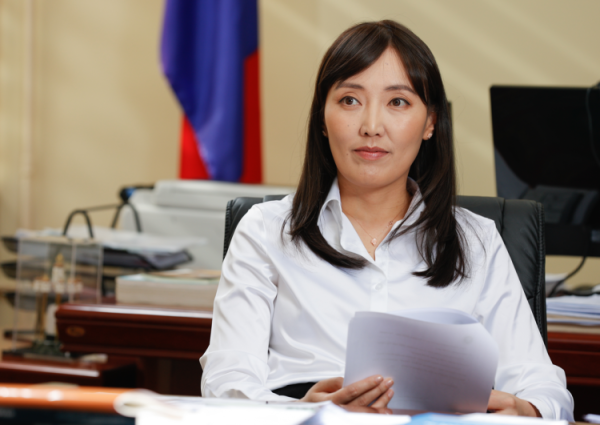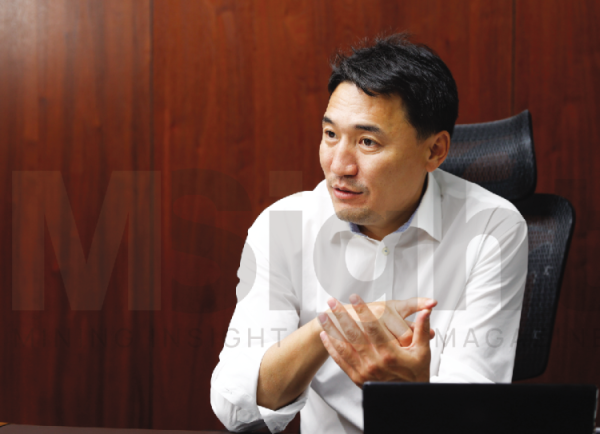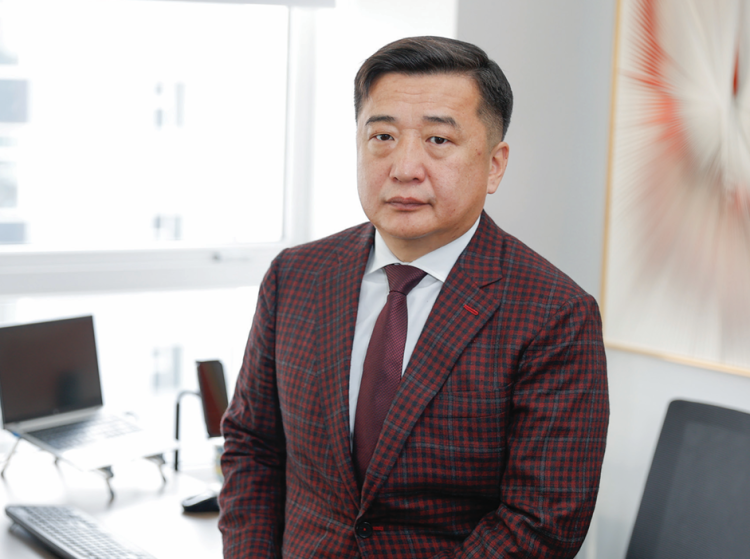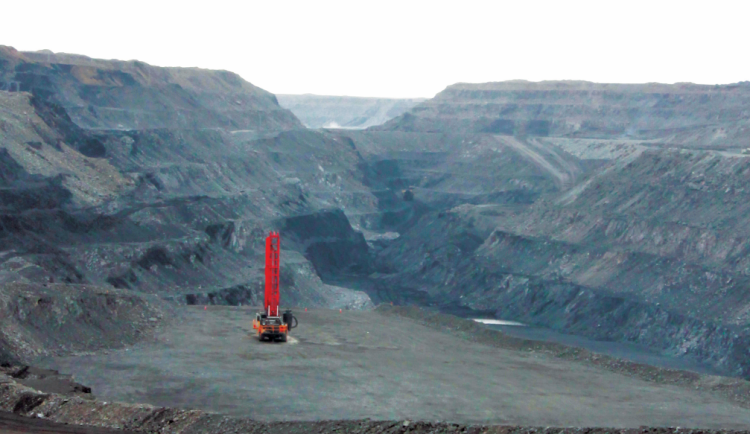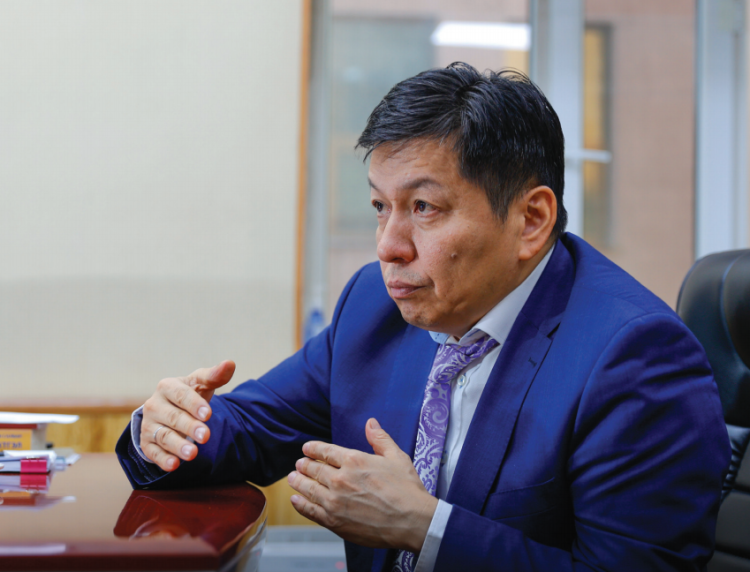 Mining Insight’s Bayartogtokh.B interviewed the Head of Mineral Resources and Petroleum Authority of Mongolia (MRPAM) Bayarmandal.L
Mining Insight’s Bayartogtokh.B interviewed the Head of Mineral Resources and Petroleum Authority of Mongolia (MRPAM) Bayarmandal.LThis year marks the 100th anniversary of the development of the mining sector in Mongolia. How would you review the last 100 years of mining sector development?
100 years is a long time. It covers almost two generations in terms of the human lifespan. We should separate the mining sector timeline into two different eras. While the private entities steered the sector for the last 30 years, the government takes credit for the former 70 years. We moved from digging coal with bare hands to one of the leading economic sectors within 70 years. Although the scale is nowhere near the world’s largest mines, we have adopted and acquired all the necessary technologies and equipment in these 70 years. The last 30 years were built on the achievements of these 70 years. But there was a significant shift in the type of ownership. Privately-owned mines and foreign investments emerged. Although there was no significant boost in technological advancement, the entire sector is striving for it. The modern development of the sector was preceded by everything accomplished during the socialist era. Our human capacity, discovered resources, explorations, and exploitations were the basis for the sector’s development.
How would you assess the roles and responsibilities of the MRPAM in these 100 years? What were the noteworthy achievements and progress?
It has been 26 years since the MRPAM was established. The core function of our authority is to regulate license related relations. Mining is, in itself, a system. It has its cadastre and is a special site in terms of occupational safety and health, therefore, it was a liability during socialism. But the government was directly responsible for everything. Regulations, assessments, and monitoring were in place, but the idea of issuing and terminating licenses was nonexistent. MRPAM, since its establishment, regulated license issuance and ensured implementations and operations. Mongolia has set up its cadastral system and adapted to modern standards, shifting from the Russian system to western practices and from manual assessment to digital methods. The authority manages all operations after the issuance of licenses. There were indeed flaws in monitoring when the number of licenses hiked. These were managed afterward. It coincided with the social transition and history of failure and accomplishment of the last 30 years. Not everything was sunshine and rainbows in these 30 years, nor was it all that bad. A lot of progress has been made while we continue to learn from our mistakes of the past. The petroleum industry regulatory body was also once separated and it is now integrated into the authority. Petroleum is a massive sector. It requires a significant amount of investment and is the key industry that singlehandedly carried the economy in the 20th century. Its impact remains strong today.
How do you envision the future development of the mining sector? What should we prioritize and improve?
Up until now, especially in the last 30 years, the mining sector played an important role in expanding the economy. The whole sector scaled up from the foundation. However, the environmental impact was high. There was a heavy focus on export volume and profit. Therefore, the next 100 years should prioritize research-based activities first, and second, a lot more improvement is required in processing. Only raw and concentrated minerals were exported so far. It is time to step up production. In addition to concentrating, there are market and development needs such as processing, advancing to the next stage, and adding value. We talked more about how many million tonnes were produced and neglected how much damage the operations caused to the environment in the past. This will change in the coming years. The next 100 years will prioritize the efficient use of water and protection of the nature. This means a set of development and standards for responsible mining. Demand for environmental and responsible mining is creating increased pressure from the market, investors, and society. This isn’t a problem specific to us, the entire world acknowledges the issue and is giving it importance. Of course, as the human factor diminishes, a more smarter and artificial intelligence-based technologies will undoubtedly emerge to replace it, which will develop even further. What is important is that the policy and vision of the industry shall be aimed at minimizing the mining impact on the environment.
NUMBER OF LICENSES TO STAY ABOVE THE CURRENT LEVEL
What are the policies and next steps of MRPAM in improving mining and local relations?
Since receiving the office on January 12, 2022, we focused on improving the selection procedure throughout the year. I believe we’ve achieved the results we wanted. We held public discussions in 18 provinces in cooperation with the Ministry of Mining and Heavy Industry (MMHI) to understand the facing issues in the sector that are specific to the region by ensuring the participation of stakeholders. I noticed something during the mission. Previous heads of our authority never visited other provinces, let alone local areas in the 26 years of operations. Maybe the misunderstanding in the local community would have been different if the authority had proper relations with the local community and shared information constantly. Government agencies have been making efforts to cut costs and minimize workplaces in recent years. But MRPAM, on the contrary, has created more jobs and, with the support of the relevant ministry, had the government issue a resolution that allows us to branch out to local regions. We’re now finding solutions to raise the necessary funds under the resolution. We’ve set up a regional plan, and in the first phase, branches will be established in Dornod, Dornogovi, Umnugovi, Khovd, and Selenge provinces as we move on to preparatory works. The provinces were selected based on the geographical locations and the number of licenses in the region. Once we move on to stable operations in these provinces and achieve ideal results, we’ll have more branches next year. Eventually, 18 provinces will have MRPAM branches. This allows for close cooperation with the local community, quick response to rising issues, and constant information sharing. We believe the action will ensure communication with the public, transparency, and prior announcement of actions.
The guidelines for submitting feasibility studies, reserve validation, and annual plans have been amended. What are the anticipated improvements and advantages of these amendments?
A study showed that about 400 reports were rejected 3000 times in the last three years. Each report is reviewed from mineral and economic terms by all relevant experts. For example, eight officials review a single mine report and each of them had the right to reject it. This posed a great deal of difficulty for businesses. So we lowered the number to five instead of eight. Plus, not all of them will have the power to refuse the report and will only be able to voice a suggestion. Three experts will review the report with their senior officials and the department head will discuss them once and have the final say. The grounds for rejection will only be reasons such as miscalculation of reserves and incorrect movement of resources. Up until now, even a small mistake, such as a miscount of pages, led to grounds for rejection. The review deadline has been set to be within three days of a working week to quicken the process. A review took about 58 days in 2020, which has been reduced to 12 days this year according to our study. I believe this is proving helpful to businesses. Also, we’ve adopted a digital system to ease the process.
What is the process of issuing exploration licenses and how many stages are there? How much did the digital and advanced licensing efforts progress in 2022? Can you review the results since you took your position? What are the challenges and difficulties you are facing?
This year, the MMHI has revised the selection procedure, which used to follow a multitude of criticism, to make it more open and transparent. The number of exploration licenses is currently at its lowest. The selection process for exploration licenses had ceased up until recently. Together with the ministry, we jointly presented the issue to the government and received support from the National Security Council (NSC), and as a result, the exploration license selection has been resumed last November. MRPAM will not issue licenses randomly at a large number, and will focus on specific criteria instead. For example, the NSC issued a guideline that prohibits licensing if the total licenses cover over 15% of the total territory of a soum. Accordingly, MRPAM announced to issue of 100 exploration licenses last November. Of the 137 licenses revoked since the start of 2022, 97 expired, or became operational and moved onto exploitation stages. From these, 47 were canceled because of nonpayment fees, damage to the environment, and nonrehabilitation. Also, permission was obtained from the MMHI to announce 14 new oil fields. An international bidding has been announced for five fields recently.
How are the interest and demand from foreign and domestic investors after the bidding announcement for 100 licensed areas? There is a strong hesitation over the inability to commence operations in local areas regardless of licenses.
The hesitation does exist. But that is not something we can fix in a day or two. The branches in other provinces will improve communications with the local community, provide information to the public, and create a common understanding. Another solution was allocating the revenue from license fees to the designated province and soum, instead of equally distributing to 330 soums through the Local Development Fund. Also, the government issued a resolution directly to local administrations, within the framework of the “New Recovery Policy”, that as long as the government has issued a license, government agencies and authorities must provide support to their operations. Since we are taking double measures to ensure transparency from both the administrative and economic sides, it will eventually be sorted out in 2-3 years, if not this year. During local discussions, some people opposed this decision. However, private entities, government officials, herdsmen, and civil societies were in on the discussion. After explaining the on-ground situation to the people and giving the environmental inspectors the right to access the cadastral system and explaining the reasons, participants came out of the discussion with positive responses. One herdsman from Govi-Altai Province said, “If you would come here, explain the laws and regulations, and provide information, we would have nothing to object to from the beginning”. The fault is also in businesses. They don’t give enough information and explain their activities when they start operations, and because of that, suspicion and mistrust arise. It is possible to reach a common understanding if you regularly meet with the local people, share news, present your work plan, provide jobs, involve the local youth, and give a clear explanations. The level of suspicion is already high because such relations have been broken for many years.
FLUORITE: A STRATEGIC MINERAL IN MONGOLIA
Critical minerals and metals are in high demand in the global market. Did the revision to the Law on Minerals include provisions about them? Also, how is the country carrying out studies and explorations in this field?
Only a handful of research was done in the past. Research and laboratory costs are high for rare earth elements. Due to the high investment costs, it has not been developed in our country. The world is now undergoing an energy transition. Moving from coal and oil to metals. In this regard, countries around the world are revising their critical mineral strategies and policies. For example, Saudi Arabia covers the exploration cost of a company that discovers a critical mineral deposit. Such policy and regulatory issues are discussed in the Minerals Law revision. The term “strategic deposits” has been abolished and replaced by the term “strategic minerals”. The policy pays more attention to critical minerals and projects implemented with state budget funds. According to the revision, the government will determine the list of strategic minerals in detail. The bill will be discussed early in 2023. However, critical minerals listed in Western countries are always based on their utility. As for Mongolia, we are a supplier, not a consumer, and the industrial sector remains underdeveloped. So there are lots to consider. For example, I think fluorite should be included in the strategic minerals of our country.
Why do you think fluorite should be included in the list of strategic minerals?
the list of strategic minerals? Fluorite is one of the most important minerals. Our neighbors China and Russia are rich in mineral resources. Although China has fluorite, its reserves are depleting, so fluorspar is considered a strategic commodity. Russia is also rich in minerals, but it does not have fluorite. All Russian and Ukrainian metallurgical plants use Mongolian fluorite. Without buying fluorite from Mongolia, their metallurgical plants cannot operate. Therefore, it is a strategically important commodity for Mongolia. But we’re lacking policy in this field. Fluorite deposits are rather unique. There is no single big deposit, it’s always just vein deposits, so there are few reserves and many small scattered ones. Therefore, the infrastructure is complicated. Experience has shown that policy support is required from the government as it is difficult for one company to manage everything. In my opinion, a state-owned enterprise, such as “Erdenes Mongol” should manage the operation.
“Mongolrostsvetmet” was in charge of fluorite production in the socialist era. Is that right?
That is true. Russians established “Mongolrostsvetment” to import fluorite from Mongolia. The price of fluorite fell during the commodity bust cycle in 2014-2015. Considering its profitability, “Mongolrostsvetmet” shifted to iron ore.
Globally, the demand for metals necessary for the green revolution and energy transition continues to grow, and exploration investments are also increasing. However, the number of exploration licenses in our country has reached a historic low. What are the resources of these metals in Mongolia?
In terms of geological conditions, our country has relatively high potential. Last year, Mongolia was ranked between Russia and Kazakhstan according to the mineral resource outlook index, which compared 84 countries. Kazakhstan is a country that attracts a lot of FDI and has a relatively developed mining sector. Mongolia is globally valued for its mineral resources and potential, which is higher than such countries. But the geological potential is only one aspect. There are many criteria such as infrastructure development, and the country’s economic and political conditions. The key takeaway is that Mongolia has an opportunity, but the problem is whether it can make use of it or not. Despite transitioning to a democratic society in 1990, Mongolia could not utilize the opportunities of the free market. The opportunity was there. Some people say Mongolia is the richest country in the world with its available resources, but it is not. Above average, but not rich. The main thing is to use what you have. At least coal should be processed. There is a lot of potentials if the iron is produced as cast iron instead of exported in concentrates.
Why are our rare earth deposits remain unexploited? It’s been a few years since the license issuance.
The group of rare earth elements consists of 15 elements. Enrichment of those elements is very difficult and involves many processing steps. First, the separation of heavy and light elements, then one by one. If you exaggerate a bit, over 20 plants are needed. The technology of using rare earth elements is complicated and very precise. Each deposit uses its technology. For example, there is only one flotation technology for copper. However, to distinguish 15 types of elements, at least 15 reagents are used. Behind this, environmental problems are difficult. If they want to neutralize many reagents, the cost will be too high for Mongolia. There are numerous environmental, technological, and infrastructure problems. Companies must have realized that they cannot do it alone and are looking to give 34 percent to the state, in exchange for policy support, which is crucial for stable operations.
In 2011, German Chancellor Angela Merkel signed a cooperation agreement in the field of minerals, industry, and technology during her visit to Mongolia. Rare earth elements were one of the topics. Did anything come out of it?
At that time, China stopped the supply of rare earth elements by setting a quota. Europe is highly dependent on rare earth elements. Although the sides can decide to move forward, it is up to the licensees to cooperate or not. But there was no investor from Germany.
During the Prime Minister’s visit to South Korea, research and analysis in the field of rare earth elements were also discussed.
arth elements were also discussed. South Korea has proposed to establish a research center for rare earth elements. They are more interested in laboratory work. But what we need is a unified policy. Take coal, for example, it followed a market-based development, not a policy. The policy and organized activities followed afterward midway into the process. Regarding rare earth elements, we can still set up a policy from the beginning. Director Kh.Badamsuren is responsible for this at “Erdenes Mongol”.
MINERALS BILL INCLUDES ENRICHMENT LICENSES
What is the main concept of the upcoming Minerals bill, which part is being revised, and what reforms have been reflected that is different from the previous ones?
The Law on Minerals covers a large scale. Since it regulates the law of the most important sector that drives our economy, there are many interested parties, both domestic and foreign. But it is necessary to revise the law. A major change is the regulation of mine closures. Arrangements for organizing and guaranteeing mine closure are included. In addition to exploration and exploitation licenses, a new type of license for enrichment is included. We’re seeing an increased number of enrichment plants that purchase ores, instead of owning a mine. So the upcoming bill will regulate such relations. In addition, socioeconomic assessments and environmental, social, and governance concepts are reflected. It covers several issues, such as how mining operations will affect the economy and technology, how many jobs will be created locally and nationwide, how much money will be spent on building infrastructure, what effects will remain in the local area after the mine closure, and more. In the course of the discussion, the terminology will change, making them more detailed and clear.
Do the reforms reflect investors’ interest in future discoveries similar to that of Oyutolgoi and Erdenet?
Royalty issues for copper and coal were addressed with a special focus on maintaining the stability of the existing laws. It should also show how the country protects the interests of investors. Before investing in our country, investors will first turn to previous investors. We will change the impression and atmosphere that Mongolians are incomprehensible and unstable by prioritizing the protection of investors’ interest.
An online platform for coal trades will be operational soon. The legal framework of the Minerals Exchange, which has been discussed for many years, is finally there. How is it processed?
The Law on Minerals Exchange will come into effect on July 1, 2023. Temporary procedures will be effective starting from January 1. Initially, stateowned enterprises must be included in the temporary regulations. It isn’t mandatory for private companies. They can begin preparation by taking part in it. “Energy Resources” LLC confirmed their participation. Implementations could be difficult as it is a new law. However, our country has no choice but to have a mineral exchange. Exchange trading provides transparency to both parties. On one hand, public frustration will be addressed. All the issues regarding lack of transparency and information, price cuts, and secret contracts will disappear after mineral exchange trading starts.
The law, which continued the 2.5 percent discount on the mineral royalty levied on gold to increase the value of gold, will expire this year. Will it be extended?
That is for the government to decide. We’ve submitted our request. In the case of gold, exploitation of gold deposits is beginning. Mining operations already started in the Khan-Altai deposit in Govi-Altai province. “Steppe Gold” is in charge of the project. “Bayan Airag” LLC project is located in Zavkhan province. Hard rock deposits take time. Since production is immediate for placer deposits, it will be significant in the next 1-2 years.
Thank you for the interview.
Mining Insight Magazine №12 (013), December 2022



